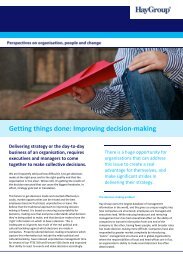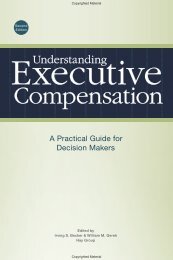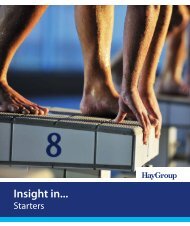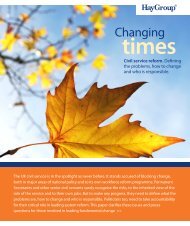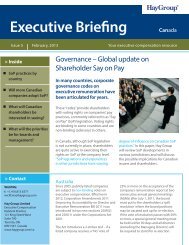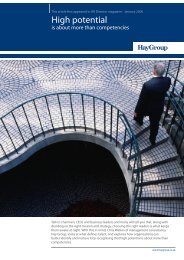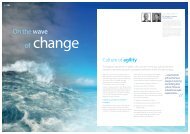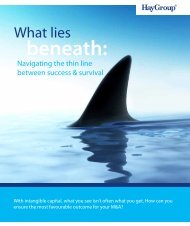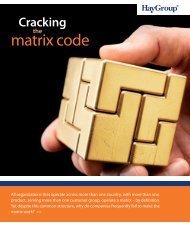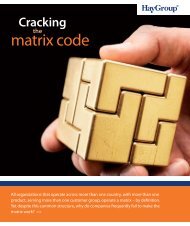Whitepaper: The silver bullet of success - Hay Group
Whitepaper: The silver bullet of success - Hay Group
Whitepaper: The silver bullet of success - Hay Group
Create successful ePaper yourself
Turn your PDF publications into a flip-book with our unique Google optimized e-Paper software.
<strong>The</strong> <strong>silver</strong><br />
<strong>bullet</strong> <strong>of</strong><br />
<strong>success</strong><br />
Winners and losers<br />
in the M&A game<br />
For those that dare to pull the trigger; the rewards <strong>of</strong> M&A remain as high as ever.<br />
But unless ‘intangible capital’ gets the senior executive attention it deserves, value<br />
will remain untapped and could even be destroyed. <strong>Hay</strong> <strong>Group</strong>’s latest research<br />
takes a look at the barriers and the <strong>silver</strong> <strong>bullet</strong> <strong>of</strong> <strong>success</strong>… >>
2 <strong>The</strong> <strong>silver</strong> <strong>bullet</strong> <strong>of</strong> <strong>success</strong>: winners and losers in the M&A game<br />
© 2010 <strong>Hay</strong> <strong>Group</strong>. All rights reserved
1<br />
Contents<br />
<strong>The</strong> gamble 3<br />
Executive summary 5<br />
<strong>The</strong> <strong>silver</strong> <strong>bullet</strong> 5<br />
Gambling with intangibles never pays 8<br />
Fool’s gold 11<br />
<strong>The</strong> barriers to integration: four clear issues 12<br />
Conclusion 18<br />
Contact us for more information 20
2 <strong>The</strong> <strong>silver</strong> <strong>bullet</strong> <strong>of</strong> <strong>success</strong>: winners and losers in the M&A game<br />
“<br />
Looking at the intangibles<br />
today is what will make the<br />
deal valuable tomorrow.<br />
David Derain | Global M&A director | <strong>Hay</strong> <strong>Group</strong><br />
“<br />
© 2010 <strong>Hay</strong> <strong>Group</strong>. All rights reserved
3<br />
<strong>The</strong> gamble<br />
<strong>The</strong> global economic meltdown has radically changed the<br />
deal landscape. Research findings from <strong>Hay</strong> <strong>Group</strong> reveal<br />
that there are several critical <strong>success</strong> factors for all executives<br />
to keep in mind which make the difference between winning<br />
and losing in the M&A game.<br />
Whilst the collapse <strong>of</strong> debt-fuelled financing put the brakes on M&A activity,<br />
the virtual disappearance <strong>of</strong> private equity investors, reduction <strong>of</strong> sovereign fund<br />
investment and a rush to divest non-core assets to shore up balance sheets, has increased<br />
opportunities for strategic M&A investments. And, as always with M&A, the stakes<br />
are high. Has deal-making become a game <strong>of</strong> Russian roulette for those who pulled<br />
the trigger and chased cheap deals?<br />
This is what led <strong>Hay</strong> <strong>Group</strong> to look again at how executives are maximising value<br />
from their M&A activities. Are businesses now paying a higher price than they<br />
expected? Partnering with mergermarket, part <strong>of</strong> the FT <strong>Group</strong>, we asked global<br />
business leaders about their experiences <strong>of</strong> integrating newly acquired businesses.<br />
Our research revealed that those actually running businesses were not necessarily<br />
aligned with shareholders on the rationale <strong>of</strong> mergers or acquisitions. Whilst half<br />
<strong>of</strong> respondents said growth was a driver for M&A activity, only four per cent aimed<br />
to increase shareholder value through deal-making.
4 <strong>The</strong> <strong>silver</strong> <strong>bullet</strong> <strong>of</strong> <strong>success</strong>: winners and losers in the M&A game<br />
Executives surveyed<br />
responded that they spend<br />
only a quarter<br />
<strong>of</strong> deal time identifying<br />
and managing the risk<br />
to intangible capital.<br />
Intangibles matter<br />
In reality, deals <strong>of</strong>ten fail to reach<br />
anywhere near the potential expected<br />
<strong>of</strong> them. Analysts say that the value<br />
<strong>of</strong> a business linked to organisational,<br />
relational or human capital – the<br />
intangibles, should be in the region <strong>of</strong><br />
75 per cent 1 <strong>of</strong> market capitalisation.<br />
Yet the executives we surveyed suggest<br />
that no more than a third <strong>of</strong> value is<br />
attributable to such intangible capital.<br />
And although there is an improvement<br />
in recognition <strong>of</strong> the importance<br />
<strong>of</strong> intangible capital to longer-term<br />
integration <strong>success</strong>, they spend only<br />
a quarter <strong>of</strong> deal time identifying<br />
and managing such risk.<br />
About the research<br />
<strong>Hay</strong> <strong>Group</strong>’s global research program was conducted in conjunction with<br />
‘mergermarket’ (part <strong>of</strong> the FT group), and questioned more than 560 senior<br />
management level executives with experience <strong>of</strong> M&A transactions worth at<br />
least $500m over the past three years.<br />
Respondents were drawn from disciplines including corporate finance, strategy,<br />
M&A, finance, risk, operations, IT and HR and included board-level executives<br />
in sectors such as financial services, industrials, energy, mining and utilities,<br />
consumer and retail, technology, media and telecommunications, pharmaceutical,<br />
medical and biotech and business services.<br />
1<br />
Source: Ocean Tomo research LLC<br />
© 2010 <strong>Hay</strong> <strong>Group</strong>. All rights reserved
5<br />
Executive summary<br />
• Companies underestimate intangible capital<br />
Executives typically value intangible capital – including culture and customer<br />
relationships – at just 30 per cent <strong>of</strong> market capitalisation, not the 75 per cent<br />
that analysts expect.<br />
• Buyers risk damaging deal value<br />
– By underestimating intangible value, they allocate insufficient resources to<br />
protecting it during integration.<br />
– Just 38 per cent <strong>of</strong> companies conduct cultural due diligence.<br />
• Management <strong>of</strong> intangible capital influences integration <strong>success</strong><br />
Companies that reviewed intangibles during due diligence are more than twice<br />
as likely to consider their merger a <strong>success</strong> compared with those who did not.<br />
• Poor management <strong>of</strong> intangible capital has major consequences<br />
Executives struggle with:<br />
– cultural integration<br />
– leadership changes<br />
– understanding the target company’s customers<br />
– governance.<br />
• Dealing with intangible capital is considered to be more challenging in<br />
cross-border transactions.<br />
• Two thirds <strong>of</strong> respondents (66 per cent) believe an increased focus on intangible<br />
capital would improve merger <strong>success</strong>.<br />
• Most business leaders (61 per cent) plan to increase their focus on intangibles<br />
but need guidance on how to capture data about intangible capital during M&As.
6 <strong>The</strong> <strong>silver</strong> <strong>bullet</strong> <strong>of</strong> <strong>success</strong>: winners and losers in the M&A game<br />
<strong>The</strong> <strong>silver</strong> <strong>bullet</strong><br />
Distress-driven, transactions are frequently conducted<br />
in tight timeframes. As a result, due diligence isn’t always<br />
diligent enough when deals are conducted at such speed.<br />
Intangible capital<br />
consists <strong>of</strong> three elements:<br />
‘organisational’, ‘relational’<br />
and ‘human’ capital.<br />
Furthermore, there is <strong>of</strong>ten a heavy<br />
focus on the financials – leading to<br />
an incomplete view <strong>of</strong> the value <strong>of</strong> the<br />
company being acquired. Consequently<br />
the handling <strong>of</strong> ‘intangible capital’, the<br />
<strong>silver</strong> <strong>bullet</strong> that is critical for <strong>success</strong> –<br />
does not always get the attention it merits.<br />
What is intangible capital?<br />
Most 90-day deal implementation plans<br />
aim to achieve quick wins by integrating<br />
‘hardwiring’ – the tangible assets such<br />
as IT, financial systems and property<br />
portfolios. But aligning intangible<br />
capital or ‘s<strong>of</strong>t wiring’ is more difficult.<br />
<strong>The</strong> <strong>Hay</strong> <strong>Group</strong> model <strong>of</strong> ‘Intangible<br />
capital’ consists <strong>of</strong> three elements:<br />
‘organisational’, relational’ and ‘human’<br />
capital, as detailed in figure one.<br />
Executives must take time to evaluate<br />
intangibles right from the start <strong>of</strong><br />
M&A activity. However, because<br />
it easy to identify and manage risks<br />
to tangible assets and difficult to<br />
audit intangible capital, priorities<br />
can remain focused on the former.<br />
<strong>The</strong> consequences can be severe.<br />
If intangible capital is disregarded,<br />
integration languishes and the<br />
synergies fail to materialise.<br />
© 2010 <strong>Hay</strong> <strong>Group</strong>. All rights reserved
7<br />
Figure one<br />
Organisational capital<br />
Culture and market convergence<br />
• Shared values, attitudes, beliefs and<br />
customs<br />
Governance<br />
• Aligned business processes<br />
• Clear and effective governance<br />
Agility<br />
• Capacity to manage internal<br />
business transformation<br />
• React quickly to new market<br />
demands<br />
Communication and teaming<br />
• Willing to share information<br />
• Simple channels/information flow<br />
Energy and clarity<br />
• Communicated and understood<br />
business strategy<br />
• Clear direction for people to<br />
mobilise their energy<br />
Organisational structure<br />
• Effectiveness <strong>of</strong> the organisation to<br />
deliver the strategy<br />
Tacit ‘know-how’ and information<br />
• Willingness to innovate<br />
• Unpatented intellectual property<br />
Relationship capital<br />
Brand<br />
• External and internal image and<br />
reputation<br />
• All that touches the customer<br />
experience<br />
Client intimacy<br />
• Knowledge <strong>of</strong> the client<br />
• Market coverage<br />
Client loyalty<br />
• Client satisfaction<br />
• Low turnover and high rate <strong>of</strong><br />
referrals<br />
External networks<br />
• Strong relationships with suppliers<br />
distributors and other partners or<br />
centers <strong>of</strong> influence<br />
Internal networks<br />
• Effective internal communication<br />
• High impact cross functional teams<br />
• Enabling relationships across<br />
organisational and geographic<br />
boundaries<br />
Human capital<br />
Leadership<br />
• Clear vision established and<br />
communicated<br />
• Conflicts <strong>of</strong> interests coordinated<br />
and balanced for all stakeholders<br />
• Team commitment and employee<br />
recognition<br />
Employees<br />
• High potentials identified,<br />
developed and rewarded<br />
• Strong commitment, loyalty and<br />
valued by the organisation<br />
Development and management<br />
• New skills, knowledge, leadership<br />
styles aquired with training and<br />
coaching<br />
Engagement<br />
• Employee empowerment and<br />
degree <strong>of</strong> attachment to the<br />
company<br />
Productivity<br />
• Efficient management <strong>of</strong> costs,<br />
resources and time
8 <strong>The</strong> <strong>silver</strong> <strong>bullet</strong> <strong>of</strong> <strong>success</strong>: winners and losers in the M&A game<br />
Gambling with intangibles never pays<br />
Corporate buyers typically value intangible capital <strong>of</strong> acquired<br />
companies far lower than that calculated by industry analysts.<br />
By undervaluing<br />
intangibles, buyers<br />
risk destroying value.<br />
Rewards come to those<br />
who measure, evaluate<br />
and value intangibles.<br />
In the <strong>Hay</strong> <strong>Group</strong> survey, executives<br />
valued intangible capital, including<br />
governance, brand behaviours, customer<br />
and supplier networks, leadership<br />
or culture at just 30 per cent <strong>of</strong> their<br />
target’s total market capitalisation.<br />
In contrast, analysts value intangible capital<br />
at closer to 75 per cent <strong>of</strong> market value in<br />
stable market conditions (figure two).<br />
By undervaluing intangibles, buyers risk<br />
destroying value. Rewards come to<br />
those who measure, evaluate and value<br />
intangibles. Yet in our survey:<br />
• nearly a third <strong>of</strong> buyers (31 per cent) did<br />
not carry out a formal intangibles review<br />
• <strong>of</strong> those who did, 70 per cent considered<br />
their merger to be a <strong>success</strong><br />
• two-thirds (66 per cent) <strong>of</strong> business<br />
leaders believe an increased and earlier<br />
focus on intangibles throughout the<br />
deal lifecycle would improve deal <strong>success</strong><br />
• almost two-thirds (61 per cent) plan<br />
to increase the focus on intangible<br />
capital in their next transaction.<br />
<strong>Hay</strong> <strong>Group</strong> experience illustrates<br />
the benefits <strong>of</strong> taking a wider view.<br />
Whilst aligning cultures is undoubtedly<br />
important to deal <strong>success</strong>, customers<br />
are paramount. Success means:<br />
• aligning approaches to customer<br />
relationship management<br />
• retaining individuals who manage<br />
mission-critical customer or supplier<br />
relationships<br />
• integrating brand value and<br />
behaviours, particularly for front-line,<br />
customer-facing employees.<br />
© 2010 <strong>Hay</strong> <strong>Group</strong>. All rights reserved
9<br />
Figure two:<br />
<strong>The</strong> estimated value <strong>of</strong> intangible capital<br />
given by respondents: international trends<br />
Overall 30<br />
India 42<br />
CEE 38<br />
South East Asia 37<br />
Western Europe 33<br />
Latin America 32<br />
US and Canada 30<br />
Australia and New Zealand 20<br />
North Asia 12<br />
(per cent)<br />
• Overall, respondents believe<br />
about 30 per cent <strong>of</strong> their own<br />
company’s market capitalisation<br />
is tied up in intangible capital.<br />
• In India, respondents believe<br />
this to be as high as 42 per cent,<br />
whilst North Asia executives say<br />
it is as low as 12 per cent.<br />
Figure three:<br />
Would an increased and earlier focus on the<br />
intangibles during the M&A process have<br />
improved the <strong>success</strong> <strong>of</strong> the M&A?<br />
Overall 66<br />
India 89<br />
CEE 86<br />
South East Asia 81<br />
Latin America 75<br />
North Asia 68<br />
Australia and New Zealand 62<br />
US and Canada 54<br />
Western Europe 52<br />
‘Yes’<br />
(per cent)<br />
Figure four:<br />
Time for intangibles?<br />
Overall 25<br />
South East Asia 33<br />
CEE 31<br />
India 28<br />
Latin America 25<br />
Western Europe 25<br />
North Asia 18<br />
US and Canada 18<br />
Australia and New Zealand 18<br />
Time Spent<br />
(per cent)<br />
• On average, executives allocate<br />
just a quarter (25 per cent) <strong>of</strong><br />
their time to the integration <strong>of</strong><br />
intangibles. This is out <strong>of</strong> step<br />
with its value.
10 <strong>The</strong> <strong>silver</strong> <strong>bullet</strong> <strong>of</strong> <strong>success</strong>: winners and losers in the M&A game<br />
© 2010 <strong>Hay</strong> <strong>Group</strong>. All rights reserved
11<br />
Fool’s gold<br />
As deals became faster, executives failed to spend time<br />
managing the risks to intangible capital. When polling<br />
respondents, <strong>Hay</strong> <strong>Group</strong> found that, where it was considered<br />
at all, intangible capital was <strong>of</strong>ten an after-thought.<br />
<strong>Hay</strong> <strong>Group</strong> global M&A director<br />
David Derain says: “Many recent financial<br />
deals have been decided rapidly, <strong>of</strong>ten in<br />
a matter <strong>of</strong> days. Due diligence around<br />
intangible capital, never very thorough<br />
in the best <strong>of</strong> times, takes even more <strong>of</strong><br />
a back seat. However, now we are seeing<br />
the fallout <strong>of</strong> poorly planned integration<br />
<strong>of</strong> intangibles as ‘one organisation’ still<br />
operates as two, with subsequent brand<br />
confusion and loss <strong>of</strong> key talent.”<br />
<strong>The</strong> gamble <strong>of</strong> financial<br />
gain can rapidly turn into<br />
fool’s gold if intangibles<br />
are neglected during<br />
due diligence.<br />
M&A <strong>success</strong> or failure – who decides?<br />
<strong>Hay</strong> <strong>Group</strong> asked executives if they measured the ‘health’ <strong>of</strong> completed M&A deals.<br />
Almost half (49 per cent) said their financial department checks what shape the<br />
company is in, leaving wide margins for error and misinterpretation on just how<br />
well the company has integrated. <strong>The</strong> finances may look good but just what has<br />
happened to the culture and morale <strong>of</strong> staff 12 months down the line? Worryingly<br />
only 31 per cent ask their board or CEO about their impressions <strong>of</strong> integration<br />
across the broader company, not just financials.<br />
Eighty per cent <strong>of</strong> respondents in Australia and New Zealand said the finance<br />
department takes the lead, possibly because they have conducted less complex<br />
deals in this region.<br />
A similar reliance on finance takes place in CEE (64 per cent), Western Europe<br />
(60 per cent) and the US and Canada (56 per cent). Businesses in Asia are more likely<br />
to look to their board or CEO to investigate the health <strong>of</strong> the newly intergrated<br />
organisation (55 per cent).
12 <strong>The</strong> <strong>silver</strong> <strong>bullet</strong> <strong>of</strong> <strong>success</strong>: winners and losers in the M&A game<br />
<strong>The</strong> largest obstacles in M&A<br />
deals<br />
Difficulties meshing the culture<br />
and market <strong>of</strong> the target<br />
company<br />
Handling the change in<br />
leadership with the target<br />
company<br />
Fully understanding the issues<br />
regarding the target company’s<br />
customer base<br />
Issues around governance<br />
within the target company<br />
<strong>The</strong> barriers to integration: four clear issues<br />
Barrier one: Culture<br />
Dealing with cultural issues <strong>of</strong> the<br />
target company is the biggest challenge<br />
to <strong>success</strong>ful post-merger integration,<br />
according to <strong>Hay</strong> <strong>Group</strong> research. This<br />
is a complex issue and during M&A,<br />
three elements <strong>of</strong> culture – national,<br />
organisational and management culture<br />
– must be considered.<br />
<strong>The</strong> difficulty is that during due diligence,<br />
buyers might not have sufficient access<br />
to the target organisation to assess<br />
cultural fit. Even if they do, culture<br />
is <strong>of</strong>ten regarded as a ‘s<strong>of</strong>t’ issue, not<br />
worthy <strong>of</strong> serious analytic thought. This<br />
is a mistake. As Deborah Allday, M&A<br />
director, <strong>Hay</strong> <strong>Group</strong> UK says: “You might<br />
win the minds <strong>of</strong> your employees, but it<br />
takes a long time to win their hearts.”<br />
Figure five<br />
Have you ever used/do you<br />
undertake cultural due<br />
diligence when conducting<br />
M&A?<br />
Overall 38<br />
US and Canada 57<br />
North Asia 51<br />
South East Asia 48<br />
CEE 45<br />
Latin America 39<br />
Australia and New Zealand 37<br />
Western Europe 28<br />
India 28<br />
‘Yes’<br />
(per cent)<br />
• Only 38 per cent <strong>of</strong> overall respondents<br />
have ever used or habitually undertake<br />
cultural due diligence. However, among<br />
the 62 per cent <strong>of</strong> respondents that<br />
do not undertake it, a third express a<br />
desire or willingness to do so in future,<br />
especially on cross-border transactions.<br />
• Cultural due diligence is most extensively<br />
employed by US and Canada respondents<br />
(57 per cent).<br />
• It is used by only 28 per cent <strong>of</strong><br />
respondents from Western Europe.<br />
A UK respondent claims that because<br />
their M&A deals have been “in North<br />
America, there is no cultural change.”<br />
An Italian respondent says that previously<br />
they didn’t believe that cultural issues<br />
were important. “It was a mistake.<br />
We will do it in the future.”<br />
© 2010 <strong>Hay</strong> <strong>Group</strong>. All rights reserved
13<br />
Barrier two: Leadership<br />
M&A activity necessarily results in<br />
leadership changes as integration takes<br />
place. How such changes are handled<br />
is the next major hurdle.<br />
A common mistake is to send<br />
contradictory messages through the<br />
selection <strong>of</strong> individuals for key positions.<br />
CEOs can too easily promote those<br />
they favor, not those that are most suited<br />
to implementing a <strong>success</strong>ful integration.<br />
Mergers are about the relationships,<br />
both formal and informal, that are<br />
forged as two distinct enterprises come<br />
together. Collaborative, empathetic<br />
skills are required.<br />
Problems with internal relationships,<br />
resistance to change and unwillingness<br />
to collaborate across organisational lines<br />
feature regularly in dysfunctional mergers.<br />
Frequently it takes too long to determine<br />
which roles and people should stay, or<br />
decisions can be made on inappropriate<br />
criteria, such as judging leadership capacity<br />
on an individual’s personal presence,<br />
rather than their capabilities in managing<br />
M&A integration.<br />
About half <strong>of</strong> respondents in our<br />
research (52 per cent) reviewed leadership<br />
capabilities during due diligence. It is<br />
not enough. If leadership is fundamental<br />
to <strong>success</strong>, the figure should be nearer<br />
100 per cent. Instead we see executive<br />
focus shift after due diligence towards<br />
the running <strong>of</strong> the business rather than<br />
the mechanics <strong>of</strong> integration.<br />
Figure six<br />
What they say<br />
“If people are unhappy with the new leadership it does create a lot <strong>of</strong> post<br />
integration issues.”<br />
Head <strong>of</strong> M&A | Financial services company | Singapore<br />
“If you don’t plan the new management team you will have uncertainty in<br />
the organisation and you will lose key people and client relationships.”<br />
Senior vice president – M&A | TMT company | United States<br />
When in the process did<br />
you pay attention to<br />
leadership and installing<br />
a new management team?<br />
Screening 36<br />
Due diligence 52<br />
Pre-closing down-time 48<br />
Post-closing 90 days 33<br />
Overall<br />
(per cent)
14 <strong>The</strong> <strong>silver</strong> <strong>bullet</strong> <strong>of</strong> <strong>success</strong>: winners and losers in the M&A game<br />
Both companies will<br />
handle CRM differently.<br />
It is vital therefore to<br />
consider how client<br />
relationships will<br />
be maintained.<br />
Barrier three: Integrating<br />
the customer base<br />
Following issues around culture and<br />
leadership, getting the most from the<br />
target company’s customer base is ranked<br />
as the next major obstacle for executives.<br />
After integration, executives can focus<br />
on internal matters to the detriment <strong>of</strong><br />
customers. At a time when customers<br />
worry about continued service levels, this<br />
is concerning and, as both customers and<br />
employees read press coverage, rumour can<br />
obscure fact. As employees communicate<br />
with customers all the time, there is much<br />
scope for misinformation and mishandling.<br />
Accordingly, during due diligence it is<br />
vital to consider how client relationships<br />
will be maintained. Both the acquiring<br />
company and that being acquired will<br />
handle client relationship management,<br />
account management and procedures such<br />
as sales processes differently. Throughout<br />
integration, customers must be at the heart<br />
<strong>of</strong> operation.<br />
Barrier four: Corporate governance<br />
Uncertainty around corporate governance,<br />
particularly where accountabilities are<br />
unclear or the operating model is in flux<br />
can cripple organisations. It is the fourth<br />
biggest barrier to integration <strong>success</strong>.<br />
Driven by legislation, the need for tax<br />
efficiency as well as the need to bring<br />
together two different sets <strong>of</strong> processes,<br />
the newly merged entity will require<br />
new governance procedures. For key<br />
senior individuals, changes in governance<br />
can result in a loss <strong>of</strong> autonomy and<br />
decision-making power. So retention<br />
strategies may be required if key people<br />
are not to leave for new opportunities.<br />
What they say<br />
“<strong>The</strong> other company might tell you that they have fantastic client relationships, but<br />
after acquiring the company, when you actually sit down and look at it, the client<br />
relationship network may not have been correctly portrayed by the other company.”<br />
Finance director | Financial services company | Malaysia<br />
“Client relationships are totally connected to management <strong>of</strong> risk… <strong>The</strong>re should be a<br />
substantial analysis <strong>of</strong> this relationship and how to maintain it after the acquisition.<br />
It is essential for the <strong>success</strong> <strong>of</strong> the acquisition that you keep them happy.”<br />
Director | Real estate company | France<br />
© 2010 <strong>Hay</strong> <strong>Group</strong>. All rights reserved
15<br />
Process and timing<br />
<strong>The</strong>re is a tipping point <strong>of</strong> about seven months (230 days, on average) when<br />
it comes to intangible capital impacting a company’s bottom line. <strong>The</strong>se seven<br />
months are the honeymoon period and defines whether the marriage is in<br />
shape for the long-term.<br />
Our research shows that once senior executives have established the<br />
integration leadership team, they give them very little time to demonstrate<br />
results. Integration <strong>success</strong> – or otherwise – is <strong>of</strong>ten judged in just under a year.<br />
Thirty-eight per cent <strong>of</strong> companies said they expected to see shareholder value<br />
returns increase within 12 months. By focusing on short-term goals, they could<br />
be derailing long-term <strong>success</strong>.<br />
Consequently, executives focus on new concerns before the company is<br />
operating on strong foundations. It is too fast. <strong>The</strong> conditions need to be in<br />
place beyond year one to continue the integration and alignment <strong>of</strong> both the<br />
intangible and tangible capital.<br />
During due diligence and pre-closing, leaders are conscious <strong>of</strong> the need to<br />
plan for certain areas <strong>of</strong> intangible integration. But this interest declines in the<br />
three months following the first crucial ninety days after deal closure, with only<br />
around a third <strong>of</strong> executives attending to issues such as structure and leadership.<br />
Executives need to maintain focus on intangibles so that they set up the right<br />
conditions for <strong>success</strong>ful integration long after the deal has been closed.<br />
<strong>The</strong>re is a tipping point<br />
<strong>of</strong> about seven months<br />
(230 days, on average)<br />
when it comes to<br />
intangible capital<br />
impacting a company’s<br />
bottom line.
16 <strong>The</strong> <strong>silver</strong> <strong>bullet</strong> <strong>of</strong> <strong>success</strong>: winners and losers in the M&A game<br />
Helping clients to navigate through the multiple priorities during each stage <strong>of</strong> the deal process:<br />
Marketing screening Due diligence Pre-closing Post-merger integration<br />
Clarification <strong>of</strong> the merger<br />
strategy<br />
Clarification <strong>of</strong> the merger<br />
strategy<br />
Clarification and communication<br />
<strong>of</strong> the merger strategy<br />
Communication <strong>of</strong> the merger<br />
strategy<br />
Assessment <strong>of</strong> the operating<br />
model<br />
Assessment <strong>of</strong> the operating<br />
model<br />
Creation <strong>of</strong> governance processes<br />
for new organisation<br />
Implementation and integration<br />
<strong>of</strong> the operating model<br />
Analysis <strong>of</strong> cultural compatibility Analysis <strong>of</strong> cultural compatibility Analysis <strong>of</strong> cultural compatibility<br />
and modelling<br />
Research into corporate<br />
reputation<br />
Analysis <strong>of</strong> reward liability and<br />
capability<br />
Review and assessment <strong>of</strong> top<br />
team capabilities<br />
Analysis <strong>of</strong> reward liabilities,<br />
risks and costs<br />
We partner with clients to work with<br />
them through each stage <strong>of</strong> the<br />
deal process. From market screening<br />
through to post-merger integration,<br />
our consultants bring M&A business<br />
expertise to translate strategic<br />
objectives into real action – we help<br />
clients implement their ‘blueprints’<br />
and ‘roadmaps’.<br />
Building <strong>of</strong> organisation structure<br />
and alignment with job design<br />
Research into corporate reputation Implementation <strong>of</strong> cultural<br />
compatibility and modelling<br />
strategy<br />
Impact analysis on the customer:<br />
pre and post merger<br />
Analysis <strong>of</strong> employee engagement<br />
and effectiveness<br />
Pulse surveys on strategic<br />
alignment<br />
Management and coaching <strong>of</strong> top<br />
team development and capabilities<br />
Assessment <strong>of</strong> emotional<br />
intelligence for new organisation<br />
competencies<br />
Assessment <strong>of</strong> climate created by<br />
leadership<br />
Creation <strong>of</strong> <strong>success</strong>ion plans for<br />
new organisation<br />
Structuring <strong>of</strong> performance<br />
management systems<br />
Analysis <strong>of</strong> reward liabilities risks,<br />
costs and pre-strategy direction<br />
Compensation planning for<br />
executives<br />
Development <strong>of</strong> govenance<br />
structure and compensation<br />
Implementation plan for<br />
compensation and benefits<br />
programme<br />
Impact analysis on the customer:<br />
post merger comparison<br />
Measurement <strong>of</strong> employee<br />
engagement and effectiveness:<br />
pre and post merger<br />
Pulse surveys on strategic<br />
alignment<br />
Management and coaching <strong>of</strong> top<br />
team development and capabilities<br />
Assessment <strong>of</strong> emotional<br />
intelligence<br />
for new organisation competencies<br />
Help to implement climate change<br />
(where required) created by<br />
leadership<br />
Delivery <strong>of</strong> <strong>success</strong>ion plans for<br />
new organisation<br />
Structuring <strong>of</strong> reward information<br />
services<br />
Creation <strong>of</strong> total reward strategy<br />
Compensation planning for<br />
executives<br />
Development <strong>of</strong> govenance<br />
structure and compensation<br />
Implementation plan for<br />
compensation and benefits<br />
programme<br />
Implemention <strong>of</strong> performance<br />
management systems<br />
© 2010 <strong>Hay</strong> <strong>Group</strong>. All rights reserved
17<br />
Regional perspective: east versus west<br />
Travelling the world – is Asia the new road for <strong>success</strong>?<br />
<strong>The</strong> historical and political landscape shapes how people behave and interact<br />
socially and pr<strong>of</strong>essionally. Our research has seen this in the way executives take<br />
business decisions both before and after deal integration.<br />
Whilst only seven per cent <strong>of</strong> respondents believe that in the next two years<br />
cross-border deals will decrease, people are increasingly working alongside very<br />
different cultures, learning how to get along in order to become one company.<br />
Executives in Asia are more likely to be open to adopting and adapting to other<br />
cultures than their counterparts in the west. Both organisational agility and<br />
personal flexibility support their new behaviours.<br />
In Western Europe, executives said that over half <strong>of</strong> their deals were<br />
cross-border (56 per cent). However, almost half (48 per cent) said that, in some<br />
cases, the integration did not work out as well as expected. <strong>The</strong> biggest barriers<br />
were leadership and culture. Despite this, almost three-quarters (71 per cent)<br />
said that they would not change their integration strategy for future deals.<br />
Executives in Asia also admit a low level <strong>of</strong> <strong>success</strong> in M&A (North Asia 40 per<br />
cent and South Asia 45 per cent). However, there is a much more positive attitude<br />
towards trying something new. Half <strong>of</strong> North Asian respondents said that they<br />
would change their strategy the next time round.<br />
One possible explanation is the importance that Asian markets place on cultural<br />
‘rules’ based on acting in the interests <strong>of</strong> the group. By contrast, western markets<br />
place greater emphasis on the individual, and here executives are more welcoming<br />
to imposed changes.
18 <strong>The</strong> <strong>silver</strong> <strong>bullet</strong> <strong>of</strong> <strong>success</strong>: winners and losers in the M&A game<br />
Conclusion<br />
Too much M&A activity fails to deliver the value expected.<br />
In a large part, this is due to neglect <strong>of</strong> the importance <strong>of</strong><br />
intangible capital – the organisational’, relational’ and<br />
‘human’ capital <strong>of</strong> the enterprise.<br />
Senior leaders brought up in a world that values hard numbers pay much attention<br />
to business fundamentals: the balance sheet, and the revenues <strong>of</strong> each business unit.<br />
A large part <strong>of</strong> due diligence is <strong>of</strong>ten left to finance departments, whilst intangible<br />
capital, and particularly organisational culture, is seen as a s<strong>of</strong>t – and therefore relatively<br />
unimportant – issue. <strong>The</strong>re are some notable differences across the world – notably<br />
in Asia where the whole is <strong>of</strong>ten valued more than the individual – but, by and large,<br />
all organisations could see greater <strong>success</strong> in their M&A activity by paying greater<br />
attention to the integration <strong>of</strong> intangibles.<br />
This requires a different approach to integration, with new capabilities and talents<br />
exhibited by people who are able to recognise and overcome the four barriers to<br />
integration – culture, leadership, customers and governance. S<strong>of</strong>t issues they may<br />
appear, but they are hard to manage, especially with cross-border transactions that<br />
involve radically different environments.<br />
However, for those that dare to pull the trigger, the rewards <strong>of</strong> M&A remain as high<br />
as ever. But unless intangible capital gets the senior executive attention it deserves,<br />
value will remain untapped and could even be destroyed. As industry analysts say,<br />
three-quarters <strong>of</strong> deal value lies in intangible capital. Very few organisations pay it<br />
that much attention – or sadly, anywhere near.<br />
© 2010 <strong>Hay</strong> <strong>Group</strong>. All rights reserved
20 <strong>The</strong> <strong>silver</strong> <strong>bullet</strong> <strong>of</strong> <strong>success</strong>: winners and losers in the M&A game<br />
Contact us for more information<br />
Australia<br />
Nicholas Conigrave<br />
Nicholas helps organisations work by partnering<br />
with leaders to build their capability in managing,<br />
developing and motivating their people to deliver<br />
outstanding results. He works with executive<br />
teams to help them build their capability through<br />
increased self awareness, experiential learning<br />
and skill building which has led to improved<br />
organisation results.<br />
Contact: nicholas.conigrave@haygroup.com<br />
Andrea Durrant<br />
Andrea has an extensive and highly <strong>success</strong>ful track<br />
record in senior management, business turnarounds<br />
and consulting experience spanning 25 years. She<br />
specialises in business performance improvement<br />
and organisational effectiveness. With deep M&A<br />
experience, she helps clients to improve their results<br />
and achieve greater traction, better outcomes and ROI<br />
from strategic objectives, manage risks involved in<br />
strategic change and to create shareholder value.<br />
Contact: andrea.durrant@haygroup.com<br />
Nida Khoury<br />
Nida is a senior consultant with 15 years experience<br />
with <strong>Hay</strong> <strong>Group</strong> in Canada and Australia. Nida<br />
specialises in assisting organisations to realise and<br />
execute their strategies through comprehensive<br />
strategic analysis, design <strong>of</strong> business operating models<br />
and alignment <strong>of</strong> organisational structures. He also<br />
provides support in change/transition management<br />
and implementation.<br />
Contact: nida.khoury@haygroup.com<br />
Henriette Rothschild<br />
Henriette is the General Manager <strong>of</strong> <strong>Hay</strong> <strong>Group</strong><br />
Pacific and is based in the Melbourne <strong>of</strong>fice. She<br />
specialises in aligning organisations, teams and<br />
individuals with organisational strategy and<br />
purpose. She has delivered <strong>success</strong>ful business<br />
solutions through working with executives and<br />
executive teams from a wide range <strong>of</strong> organisations.<br />
Contact: henriette.rothschild@haygroup.com<br />
Helen Scotts<br />
Helen consults regularly to executive teams, boards<br />
and senior executives on team effectiveness and<br />
leadership development. She helps organisations<br />
work by understanding their business challenges<br />
and developing and implementing solutions to<br />
deliver improved performance from leaders and<br />
employees.<br />
Contact: helen.scotts@haygroup.com<br />
David Southall<br />
David helps organisations to make insightful<br />
decisions about business models, culture, leadership,<br />
organisational design, performance and rewards. His<br />
focus is on helping leaders to create the conditions<br />
where people can and will perform at their best.<br />
Contact: david.southall@haygroup.com<br />
About <strong>Hay</strong> <strong>Group</strong><br />
<strong>Hay</strong> <strong>Group</strong> is a global consulting<br />
firm that works with leaders to turn<br />
strategy into reality. With 85 <strong>of</strong>fices<br />
in 47 countries, we work with over<br />
7,000 clients across the world to<br />
develop talent, organise people to be<br />
more effective, and motivate them to<br />
perform at their best.<br />
© 2010 <strong>Hay</strong> <strong>Group</strong>. All rights reserved
21<br />
“<br />
We<br />
partner with clients to work with<br />
them through each stage <strong>of</strong> the deal<br />
process. From market screening through<br />
to post-merger integration, our consultants<br />
bring M&A business expertise to translate<br />
strategic objectives into real action –<br />
we help clients implement their ‘blueprints’<br />
and ‘roadmaps’. ”
Africa<br />
Cape Town<br />
Johannesburg<br />
Pretoria<br />
Asia<br />
Bangkok<br />
Beijing<br />
Hong Kong<br />
Jakarta<br />
Kuala Lumpur<br />
Mumbai<br />
New Delhi<br />
Seoul<br />
Shanghai<br />
Shenzhen<br />
Singapore<br />
Tokyo<br />
Europe<br />
Athens<br />
Barcelona<br />
Berlin<br />
Bilbao<br />
Birmingham<br />
Bratislava<br />
Bristol<br />
Brussels<br />
Bucharest<br />
Budapest<br />
Dublin<br />
Frankfurt<br />
Glasgow<br />
Helsinki<br />
Istanbul<br />
Kiev<br />
Lille<br />
Lisbon<br />
London<br />
Madrid<br />
Manchester<br />
Milan<br />
Moscow<br />
Oslo<br />
Paris<br />
Prague<br />
Rome<br />
Stockholm<br />
Strasbourg<br />
Vienna<br />
Vilnius<br />
Warsaw<br />
Zeist<br />
Zurich<br />
Middle East<br />
Dubai<br />
Tel Aviv<br />
North America<br />
Atlanta<br />
Boston<br />
Calgary<br />
Charlotte<br />
Chicago<br />
Dallas<br />
Edmonton<br />
Halifax<br />
Kansas City<br />
Los Angeles<br />
Mexico City<br />
Montreal<br />
New York Metro<br />
Ottawa<br />
Philadelphia<br />
Regina<br />
San Francisco<br />
San Josè (CR)<br />
Toronto<br />
Vancouver<br />
Washington DC Metro<br />
Pacific<br />
Auckland<br />
Brisbane<br />
Canberra<br />
Melbourne<br />
Perth<br />
Sydney<br />
Wellington<br />
South America<br />
Bogota<br />
Buenos Aires<br />
Caracas<br />
Lima<br />
Santiago<br />
Sao Paulo<br />
<strong>Hay</strong> <strong>Group</strong> is a global management consulting firm that works with<br />
leaders to transform strategy into reality. We develop talent, organise<br />
people to be more effective and motivate them to perform at their<br />
best. Our focus is on making change happen and helping people<br />
and organisations realise their potential.<br />
We have over 2600 employees working in 85 <strong>of</strong>fices in 47 countries.<br />
Our clients are from the private, public and not-for-pr<strong>of</strong>it sectors,<br />
across every major industry. For more information please contact<br />
your local <strong>of</strong>fice through www.haygroup.com



